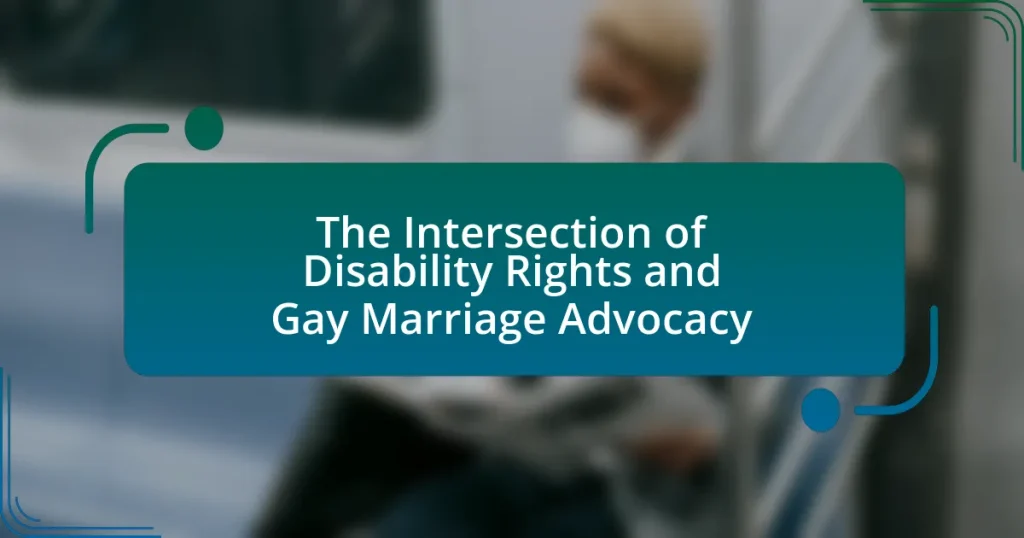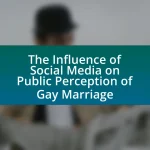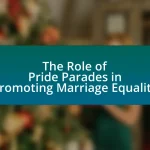The article examines the intersection of disability rights and gay marriage advocacy, highlighting their shared goals of equality and recognition for marginalized groups. It discusses how both movements address systemic discrimination and promote inclusive policies that consider the unique challenges faced by individuals at the intersection of these identities. Key historical events, societal perceptions, and legal barriers are analyzed to illustrate the complexities of this intersection, along with the role of advocacy groups in promoting awareness and understanding. The article emphasizes the significance of inclusive policies and ongoing advocacy in shaping future legislation and improving the lives of disabled LGBTQ+ individuals.
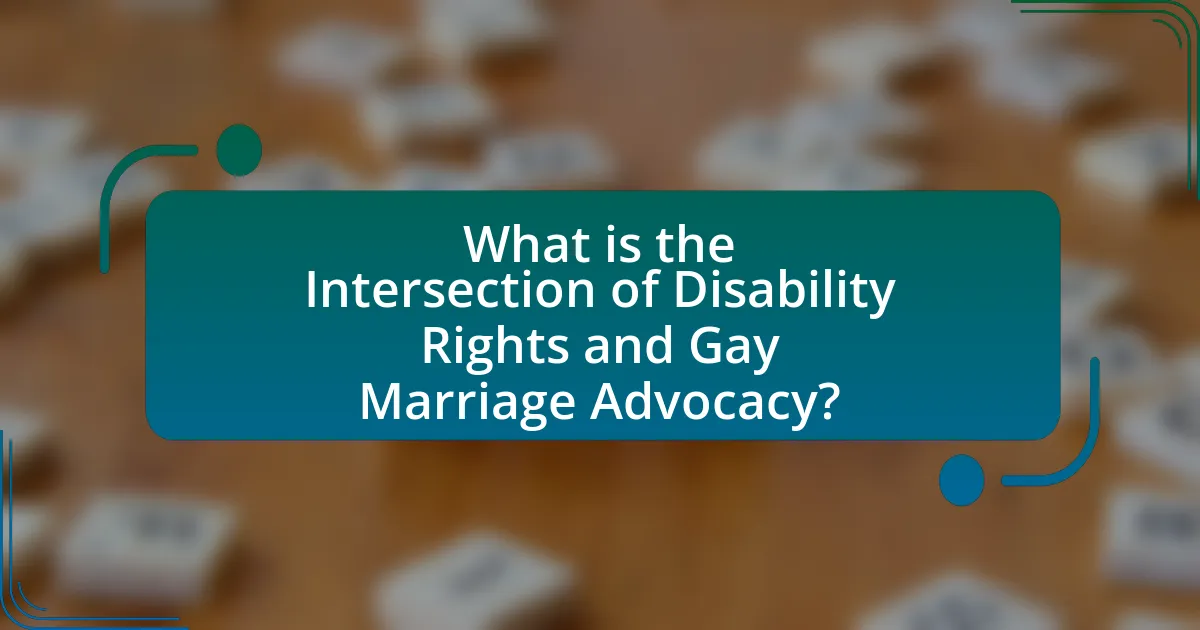
What is the Intersection of Disability Rights and Gay Marriage Advocacy?
The intersection of disability rights and gay marriage advocacy lies in the shared pursuit of equality and recognition for marginalized groups. Both movements advocate for the legal and social recognition of relationships and identities that have historically faced discrimination. For instance, the legalization of same-sex marriage in various jurisdictions has often included provisions that protect the rights of individuals with disabilities, ensuring that they have equal access to marriage benefits and protections. Additionally, both movements emphasize the importance of inclusive policies that address the unique challenges faced by individuals at the intersection of these identities, such as access to healthcare and social services. This intersection is further supported by organizations that advocate for both disability rights and LGBTQ+ rights, highlighting the need for comprehensive approaches to equality that encompass all aspects of identity.
How do disability rights and gay marriage advocacy relate to each other?
Disability rights and gay marriage advocacy relate to each other through their shared focus on equality and civil rights. Both movements seek to dismantle systemic discrimination and promote the recognition of diverse identities and relationships. For instance, the legalization of gay marriage has highlighted the need for inclusive policies that also consider the rights of individuals with disabilities, ensuring that all couples, regardless of sexual orientation or ability, have access to the same legal protections and benefits. Additionally, both movements have historically intersected in their advocacy efforts, as seen in the collaboration between LGBTQ+ activists and disability rights organizations to address overlapping issues such as healthcare access and social support systems.
What historical events have shaped the intersection of these movements?
The intersection of disability rights and gay marriage advocacy has been shaped by several key historical events, notably the Stonewall Riots of 1969 and the Americans with Disabilities Act (ADA) of 1990. The Stonewall Riots marked a pivotal moment in LGBTQ+ activism, galvanizing efforts for equality and influencing various social justice movements, including disability rights. The ADA, which prohibited discrimination based on disability, created a legal framework that intersected with the fight for marriage equality, emphasizing the importance of inclusivity in civil rights. Additionally, the emergence of intersectionality as a concept in the late 20th century highlighted the overlapping struggles of marginalized groups, further intertwining the narratives of disability rights and LGBTQ+ advocacy.
How do societal perceptions influence both disability rights and gay marriage?
Societal perceptions significantly influence both disability rights and gay marriage by shaping public attitudes, policies, and advocacy efforts. For instance, increased visibility and acceptance of LGBTQ+ individuals have led to greater support for gay marriage, as evidenced by the U.S. Supreme Court’s 2015 decision in Obergefell v. Hodges, which legalized same-sex marriage nationwide, reflecting changing societal norms. Similarly, the growing recognition of disability rights, highlighted by the Americans with Disabilities Act of 1990, demonstrates how societal attitudes can lead to legislative changes that promote equality and inclusion for people with disabilities. Both movements benefit from shifting perceptions that advocate for human rights and challenge discrimination, illustrating the interconnectedness of social justice issues.
What are the key challenges faced at this intersection?
The key challenges faced at the intersection of disability rights and gay marriage advocacy include the lack of inclusive policies, societal stigma, and accessibility issues. Inclusive policies often fail to address the unique needs of individuals with disabilities within the LGBTQ+ community, leading to inadequate legal protections. Societal stigma surrounding both disabilities and non-heteronormative relationships can result in discrimination and marginalization, making it difficult for individuals to advocate for their rights. Additionally, accessibility issues in marriage ceremonies and related services can hinder participation for disabled individuals, further complicating their ability to engage fully in the institution of marriage.
How do legal barriers affect individuals with disabilities in same-sex marriages?
Legal barriers significantly hinder individuals with disabilities in same-sex marriages by limiting their access to essential rights and benefits. For instance, discriminatory laws can prevent same-sex couples from obtaining spousal benefits, such as health insurance or social security, which are crucial for individuals with disabilities who may rely on these resources for their well-being. Additionally, legal obstacles can complicate matters related to guardianship, inheritance, and medical decision-making, creating further challenges for disabled individuals in same-sex marriages. Research indicates that these barriers exacerbate the vulnerabilities faced by disabled individuals, as they often experience higher rates of poverty and social isolation, making equitable access to legal protections vital for their quality of life.
What role does discrimination play in the experiences of disabled LGBTQ+ individuals?
Discrimination significantly impacts the experiences of disabled LGBTQ+ individuals by exacerbating their marginalization and limiting their access to essential services and rights. This group faces unique challenges due to the intersectionality of their identities, leading to compounded discrimination based on both disability and sexual orientation. For instance, a study published in the Journal of Homosexuality found that disabled LGBTQ+ individuals reported higher rates of discrimination in healthcare settings, which can hinder their ability to receive adequate medical care. Additionally, the 2015 U.S. Transgender Survey revealed that 46% of respondents with disabilities experienced harassment in public spaces, illustrating the pervasive nature of discrimination they encounter. Such experiences not only affect their mental health but also restrict their participation in social, economic, and political life, further entrenching systemic inequalities.

Why is the intersection of these rights significant in contemporary society?
The intersection of disability rights and gay marriage advocacy is significant in contemporary society because it highlights the importance of inclusivity and equality for marginalized groups. This intersection emphasizes that both individuals with disabilities and LGBTQ+ individuals face systemic discrimination, and addressing their rights together fosters a more comprehensive approach to social justice. For instance, the Americans with Disabilities Act (ADA) and the legalization of same-sex marriage in the U.S. through the Obergefell v. Hodges decision in 2015 demonstrate legal recognition of these rights, which is crucial for ensuring equal treatment and access to services. By advocating for both rights simultaneously, society can create a more equitable environment that acknowledges and supports the diverse experiences of all individuals.
What impact does the intersection have on policy-making?
The intersection of disability rights and gay marriage advocacy significantly influences policy-making by promoting inclusive legislation that addresses the needs of both communities. This intersection encourages lawmakers to consider the unique challenges faced by individuals with disabilities within the context of marriage equality, leading to policies that ensure equal rights and protections. For instance, the Americans with Disabilities Act (ADA) and marriage equality rulings have prompted discussions on accessibility in marriage services and benefits, highlighting the necessity for comprehensive policies that encompass both disability rights and LGBTQ+ rights. This collaborative approach fosters a more equitable legal framework, ensuring that all individuals, regardless of their sexual orientation or disability status, receive fair treatment under the law.
How can inclusive policies benefit both movements?
Inclusive policies can benefit both disability rights and gay marriage advocacy movements by promoting equality and reducing discrimination. These policies create a framework that recognizes the rights of all individuals, regardless of sexual orientation or disability status, fostering a more inclusive society. For instance, research shows that inclusive policies can lead to increased social acceptance and support for marginalized groups, as seen in countries that have enacted comprehensive anti-discrimination laws. This legal recognition not only empowers individuals but also encourages collaboration between movements, amplifying their voices and shared goals for equality.
What examples exist of successful advocacy at this intersection?
Successful advocacy at the intersection of disability rights and gay marriage advocacy includes the efforts of organizations like the National LGBTQ Task Force and the American Association of People with Disabilities (AAPD). These organizations collaborated to ensure that the legalization of same-sex marriage included protections for individuals with disabilities. For instance, the 2015 Supreme Court ruling in Obergefell v. Hodges, which legalized same-sex marriage nationwide, was influenced by advocacy that highlighted the unique challenges faced by disabled LGBTQ individuals, such as access to healthcare and social security benefits. This advocacy emphasized the importance of inclusive policies that address both sexual orientation and disability, demonstrating a successful intersectional approach.
How do advocacy groups address the needs of both communities?
Advocacy groups address the needs of both communities by promoting inclusive policies that recognize the rights of individuals with disabilities and the LGBTQ+ community. These organizations often collaborate to ensure that legislation, such as the Americans with Disabilities Act and marriage equality laws, encompasses protections for all individuals, regardless of sexual orientation or disability status. For instance, the Human Rights Campaign and the National Council on Independent Living have worked together to advocate for comprehensive healthcare access that addresses the unique challenges faced by both groups, demonstrating a commitment to intersectionality in their advocacy efforts.
What strategies are employed to promote awareness and understanding?
Strategies employed to promote awareness and understanding include educational campaigns, community engagement, and advocacy initiatives. Educational campaigns utilize workshops, seminars, and online resources to inform the public about the intersection of disability rights and gay marriage advocacy, highlighting the importance of inclusivity. Community engagement fosters dialogue through events and support groups, allowing individuals to share experiences and perspectives. Advocacy initiatives involve collaboration with organizations to influence policy changes, ensuring that both disability rights and LGBTQ+ rights are recognized and protected. These strategies are supported by research indicating that increased awareness leads to greater acceptance and support for marginalized communities.
How do coalitions between disability rights and LGBTQ+ organizations function?
Coalitions between disability rights and LGBTQ+ organizations function by fostering collaboration to address shared issues of discrimination and social justice. These coalitions leverage their combined resources and advocacy efforts to promote inclusive policies that benefit both communities, such as accessible healthcare and anti-discrimination laws. For instance, the collaboration has been evident in campaigns for the Americans with Disabilities Act and marriage equality, where both groups have united to challenge systemic barriers. Research indicates that intersectional advocacy enhances visibility and effectiveness, as seen in joint initiatives like the Disability Justice movement, which emphasizes the importance of inclusivity for all marginalized identities.
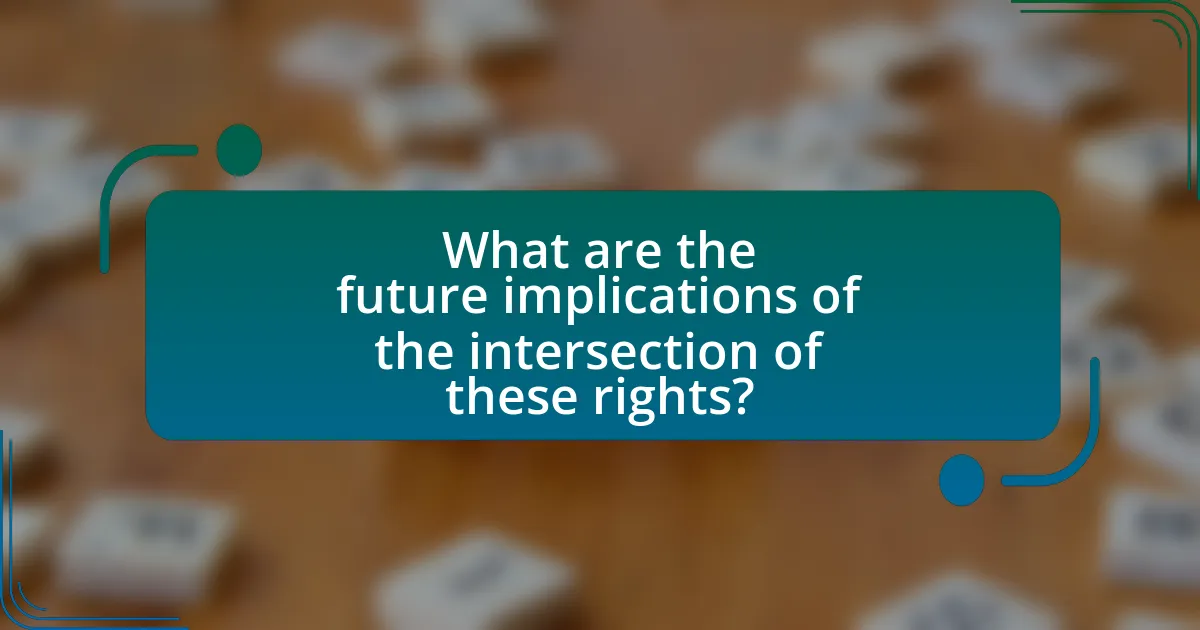
What are the future implications of the intersection of these rights?
The future implications of the intersection of disability rights and gay marriage advocacy include enhanced legal protections and increased social acceptance for marginalized groups. As both movements gain momentum, they may lead to comprehensive legislation that addresses discrimination based on sexual orientation and disability, fostering an inclusive society. For instance, the Americans with Disabilities Act and marriage equality rulings have set precedents that can be leveraged to advocate for broader rights, ensuring that individuals with disabilities who are also part of the LGBTQ+ community receive equal treatment. This intersectionality can also promote awareness and understanding, potentially reducing stigma and improving access to resources and support systems for these individuals.
How can ongoing advocacy shape future legislation?
Ongoing advocacy can shape future legislation by influencing public opinion and mobilizing grassroots support for specific issues. Advocacy efforts, such as campaigns and lobbying, can raise awareness about the needs and rights of marginalized groups, including individuals with disabilities and LGBTQ+ communities. For instance, the successful advocacy for the Americans with Disabilities Act in 1990 demonstrated how sustained efforts can lead to significant legislative changes that protect the rights of people with disabilities. Additionally, the push for marriage equality in the United States, culminating in the Supreme Court’s decision in Obergefell v. Hodges in 2015, illustrates how advocacy can shift societal norms and prompt legislative action. These examples show that ongoing advocacy not only highlights critical issues but also creates a framework for lawmakers to address them through new laws and policies.
What role does public opinion play in advancing these rights?
Public opinion significantly influences the advancement of disability rights and gay marriage advocacy by shaping societal norms and political agendas. When a majority of the public supports these rights, it creates pressure on lawmakers to enact legislation that protects and promotes equality. For instance, a 2015 Gallup poll indicated that 60% of Americans supported same-sex marriage, which contributed to the Supreme Court’s decision in Obergefell v. Hodges, legalizing it nationwide. Similarly, increased public awareness and acceptance of disability rights have led to stronger advocacy efforts and legislative changes, such as the Americans with Disabilities Act of 1990, which was bolstered by widespread public support for disability inclusion. Thus, public opinion acts as a catalyst for legal reforms and societal acceptance in both areas.
How can technology aid in the advocacy for both movements?
Technology can aid in the advocacy for both disability rights and gay marriage by facilitating communication, raising awareness, and mobilizing support. Social media platforms enable activists to share personal stories and experiences, which can humanize issues and foster empathy among broader audiences. For instance, campaigns like #DisabilityRights and #LoveIsLove have successfully utilized platforms such as Twitter and Instagram to reach millions, creating a sense of community and solidarity. Additionally, online petitions and crowdfunding platforms have empowered individuals to organize and fund initiatives that promote equality and accessibility, demonstrating the tangible impact of technology in driving social change.
What practical steps can individuals take to support this intersection?
Individuals can support the intersection of disability rights and gay marriage advocacy by actively participating in inclusive advocacy groups that address both issues. Engaging with organizations such as the Human Rights Campaign or the National Council on Independent Living allows individuals to amplify voices that represent both communities. Additionally, individuals can educate themselves and others about the unique challenges faced by disabled LGBTQ+ individuals, fostering awareness and understanding. Supporting legislation that protects the rights of both disabled individuals and same-sex couples, such as the Americans with Disabilities Act and marriage equality laws, is crucial. Volunteering time or resources to campaigns that promote accessibility and inclusivity in LGBTQ+ spaces further strengthens this intersection.
How can allies effectively advocate for both disability rights and gay marriage?
Allies can effectively advocate for both disability rights and gay marriage by promoting inclusive policies that recognize the intersectionality of these movements. This can be achieved through collaborative efforts that unite advocacy groups, ensuring that both issues are represented in legislative agendas. For instance, the Americans with Disabilities Act and marriage equality laws can be highlighted together in campaigns to emphasize the importance of equal rights for all individuals, regardless of sexual orientation or disability status. Research shows that intersectional advocacy increases visibility and support, as seen in the work of organizations like the Human Rights Campaign, which actively includes disability rights in their LGBTQ+ initiatives.
What resources are available for education and activism in this area?
Resources available for education and activism at the intersection of disability rights and gay marriage advocacy include organizations such as the Human Rights Campaign, which provides educational materials and advocacy tools focused on LGBTQ+ rights, including those related to disability. Additionally, the National Council on Independent Living offers resources that address the needs of disabled individuals within the LGBTQ+ community, promoting inclusive policies and practices. Research studies, such as “Disability and LGBTQ+ Rights: A Comparative Analysis” published in the Journal of Social Issues, highlight the unique challenges faced by individuals at this intersection, providing valuable insights for activists and educators. These resources collectively support efforts to raise awareness and promote equality for disabled LGBTQ+ individuals.
